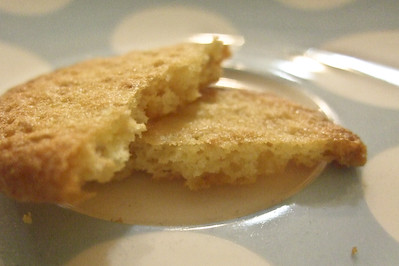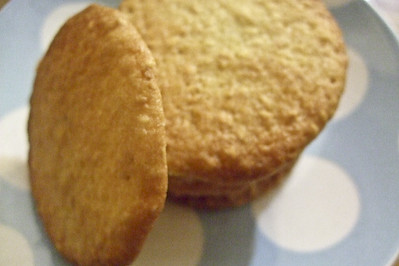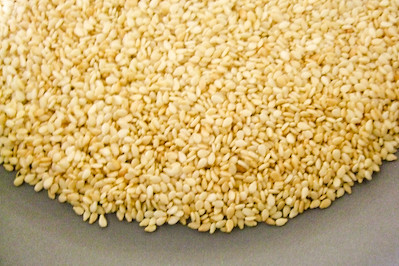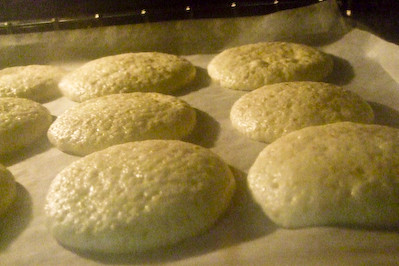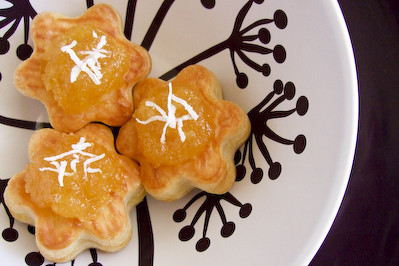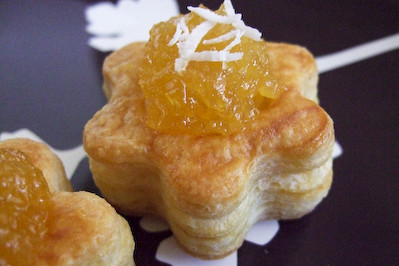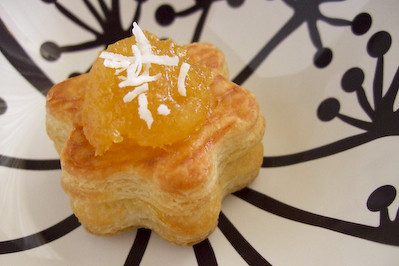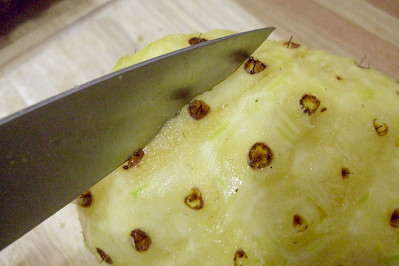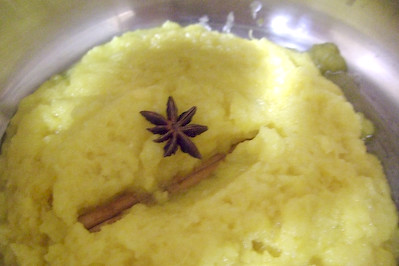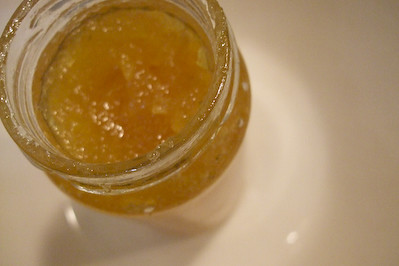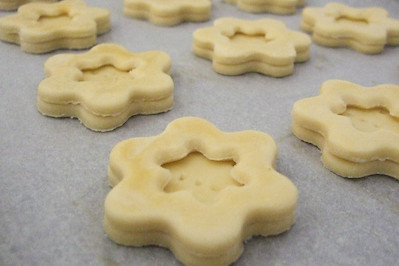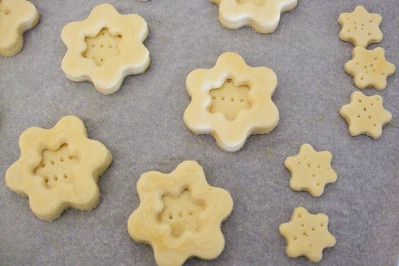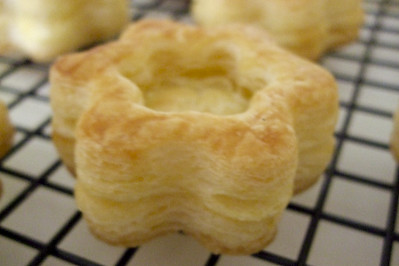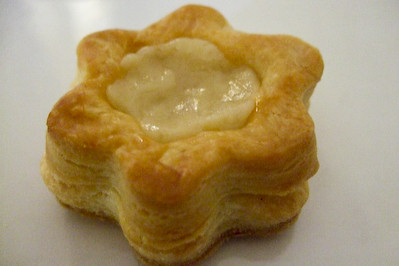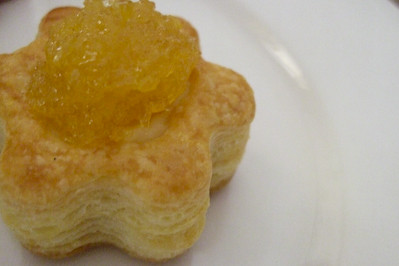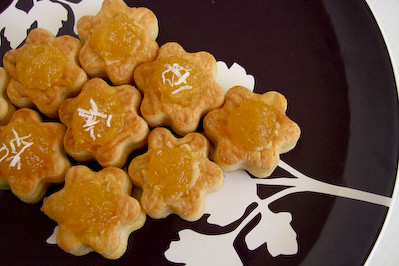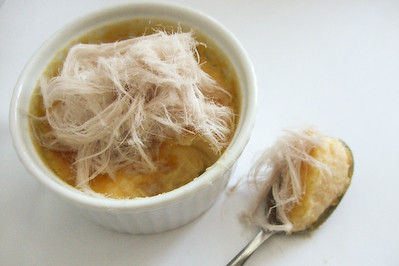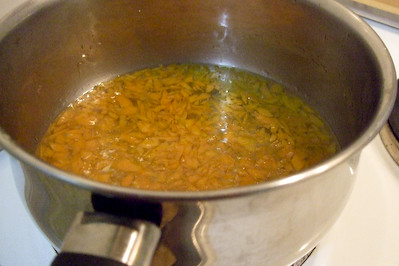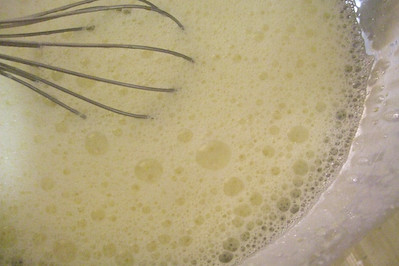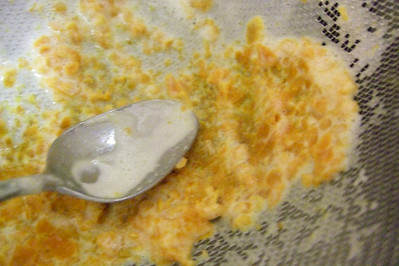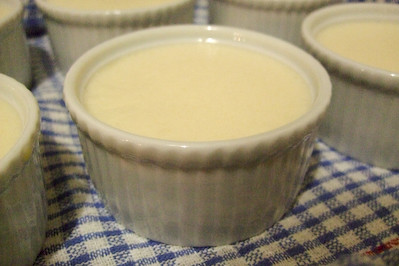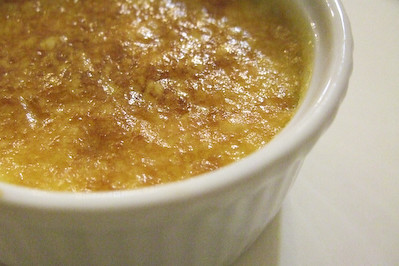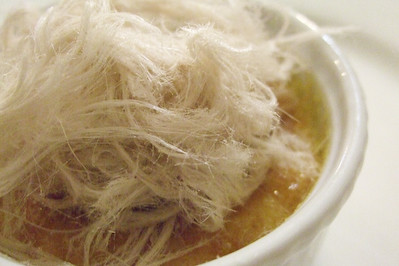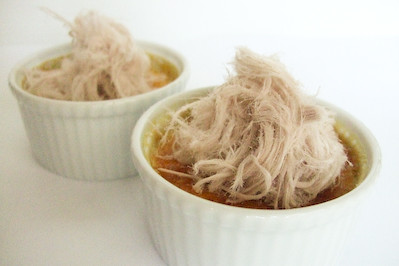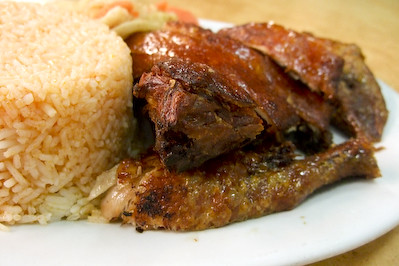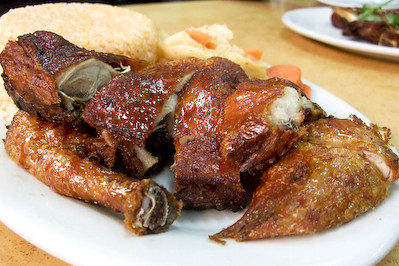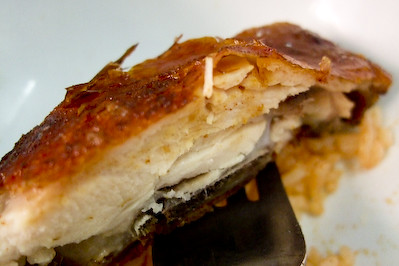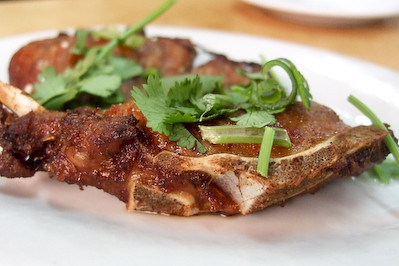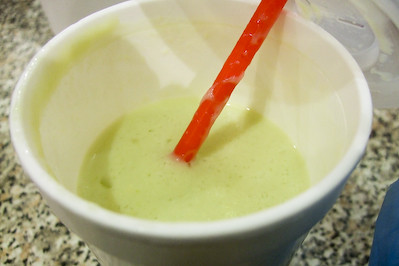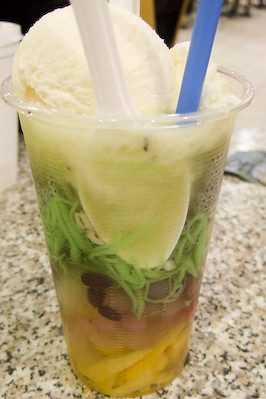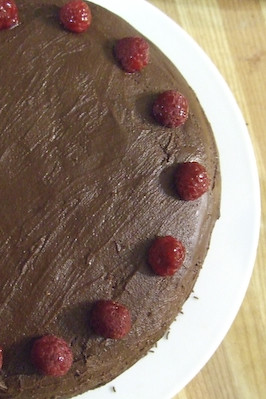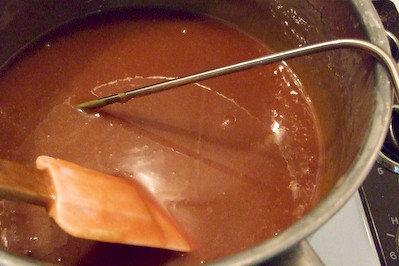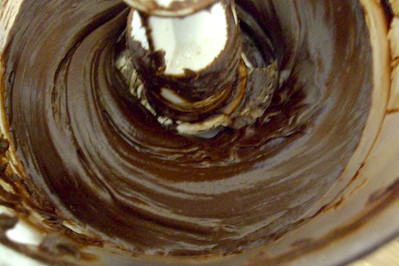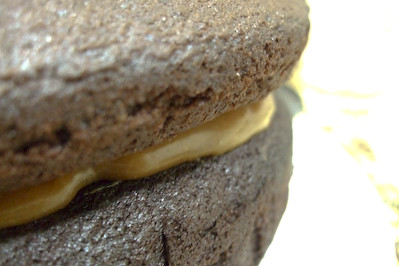If you had told me a year ago that I would soon have my own food blog I wouldn't have believed you for one single second. If you told me six months ago that I would be taking part in the Daring Bakers' challenges I would have laughed in your face. I could barely bake a plain yellow cake back then, and I used to read all the Daring Bakers' posts in complete awe of all the amazing creations that these talented bakers came up with. But the last few months (thanks to some healthy nagging from
Lisa and
Karen) I've been working up the courage to join and now I'm so glad that I finally did.
The September 2009 Daring Bakers' challenge was hosted by Steph of A Whisk and a Spoon. She chose the French treat, Vols-au-Vent based on the Puff Pastry recipe by Michel Richard from the cookbook Baking With Julia by Dorie Greenspan.
I was simultaneously thrilled and freaked out after finding out we would be making puff pastry from scratch for my first ever challenge. It's always something I've wanted to try making but the fairly long instructions and all that rolling and turning was slightly intimidating for a messy baker like myself who has had some disasters with pastry in the past. But the great instructions and Steph's extra tips, plus this wonderful
online video of Julia Child and Michel Richard making the puff pastry, were incredibly useful and made the whole process a lot less scary. Besides the need for patience while chilling the dough, I found the recipe very straightfoward and the dough was wonderfully easy to work with. In fact, at one point as I was making a turn and was having so much fun that I started giggling deliriously and yelling "I love baking!". My boyfriend backed out of the kitchen slowly with a nervous look in his eye.
At first I was planning to do a savoury vols-au-vent but then I realised that pineapples were coming back into season here. I've been wanting to make
Malaysian pineapple tarts for the longest time, and I thought the sticky, fragrant pineapple jam (stewed with cinnamon and star anise) would be a lovely match for these light, buttery puff pastry cases. For a twist, and to balance out the intense sweetness of the jam, I first filled them with a bit of pastry cream flavoured with coconut milk and then topped it off with the jam.
The puff pastry turned out beautifully flaky and layered, though on the edges of my cases the rise was slightly hindered due to the crappy plastic cutters that I used. Even so, the texture and taste were even better than I had hoped, and I think it may be hard for me to ever go back to using frozen puff now! I was also excited to find out my pineapple jam recipe tasted just like how I remembered, and these sweet, bite-sized vol-au-vents are a great little treat for an afternoon tea.
Pineapple Jam & Coconut Vols-au-VentYield: 1/3 of the puff pastry recipe below will yield about 8-10 1.5" vols-au-vent or 4 4" vols-au-ventWell-chilled puff pastry dough (recipe below)
egg wash (1 egg or yolk beaten with a small amount of water)
For the pineapple jam:2-3 not very ripe pineapples
1 cinnamon stick
Star anise
300g caster sugar
For the coconut pastry cream:1 cup coconut milk
3 large egg yolks
1/4 cup cornflour
1/4 cup sugar
Optional: shredded coconut for decoration
Skin pineapples, cut both ends off and remove the 'eyes' by slicing diagonally underneath them, following each of the spiralling line of eyes from the top to the bottom of the pineapple. This is something I used to find horribly tedious, but gets pretty easy with some practice. (Unfortunately it also means that I'm the one who gets stuck with the job of chopping them up whenever we buy them now.) Grate the pineapples in a circular motion, this helps to reduce the fibrous texture. Drain the juice from the grated pulp using a sieve (and save the juice to drink of course!) for 10 minutes.
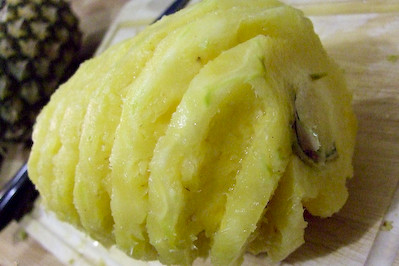
My two pineapples yielded 1 1/2 cups of pulp, if you end up with more or less feel free to vary the amount of sugar in the recipe accordingly. Place pulp, 1 cinnamon stick and 1 star anise in a medium saucepan and boil over medium heat for 30 minutes to reduce the water content, stirring frequently to prevent burning. When the mixture looks dry, add the 300g of sugar, stirring constantly until it is mixed through. Reduce the heat slight and cook slowly, stirring very regularly until the jam is thick in consistency and dark golden in colour.
Pour the jam straight into warmed glass jars and cover immediately. I made this the night before baking my vols-au-vent, but this jam can be stored for months in the fridge.
Using a knife or metal bench scraper, divided your chilled puff pastry dough into three equal pieces. Work with one piece of the dough, and leave the rest wrapped and chilled.
On a lightly floured surface, roll the piece of dough into a rectangle about 1/8 to 1/4-inch (3-6 mm) thick. Transfer it to the baking sheet and refrigerate for about 10 minutes before proceeding with the cutting.
(This assumes you will be using round cutters, but if you do not have them, it is possible to cut square vols-au-vents using a sharp chef’s knife.
As you can tell, I used flower-shaped cutters, since Malaysian pineapple tarts are traditionally made with flower or crinkle shaped biscuits) For smaller , hors d'oeuvre sized vols-au-vent, use a 1.5" round cutter to cut out 8-10 circles. (
This is the size I made)For larger sized vols-au-vent, fit for a main course or dessert, use a 4" cutter to cut out about 4 circles. Make clean, sharp cuts and try not to twist your cutters back and forth or drag your knife through the dough. Half of these rounds will be for the bases, and the other half will be for the sides. (Save any scrap by stacking—not wadding up—the pieces…they can be re-rolled and used if you need extra dough. If you do need to re-roll scrap to get enough disks, be sure to use any rounds cut from it for the bases, not the ring-shaped sides.)
Using a ¾-inch cutter for small vols-au-vent, or a 2- to 2.5-inch round cutter for large, cut centers from half of the rounds to make rings. These rings will become the sides of the vols-au-vent, while the solid disks will be the bottoms. You can either save the center cut-outs to bake off as little "caps" for you vols-au-vent, or put them in the scrap pile.
Dock the solid bottom rounds with a fork (prick them lightly, making sure not to go all the way through the pastry) and lightly brush them with egg wash. Place the rings directly on top of the bottom rounds and very lightly press them to adhere. Brush the top rings lightly with egg wash, trying not to drip any down the sides (which may inhibit rise). If you are using the little "caps", dock and egg wash them as well.
Refrigerate the assembled vols-au-vent on the lined baking sheet while you pre-heat the oven to 400ºF (200ºC). (You could also cover and refrigerate them for a few hours at this point.)
Once the oven is heated, remove the sheet from the refrigerator and place a silicon baking mat (preferred because of its weight) or another sheet of parchment over top of the shells. This will help them rise evenly. Bake the shells until they have risen and begin to brown, about 10-15 minutes depending on their size. Reduce the oven temperature to 350ºF (180ºC), and remove the silicon mat or parchment sheet from the top of the vols-au-vent. If the centers have risen up inside the vols-au-vent, you can gently press them down. Continue baking (with no sheet on top) until the layers are golden, about 15-20 minutes more. (If you are baking the center “caps” they will likely be finished well ahead of the shells, so keep an eye on them and remove them from the oven when browned.
I didn't use the caps, but ate them like they were popcorn hahaha!)
Remove to a rack to cool. Cool to room temperature.
For the pastry cream, combine 1/4 cup sugar and and 3 egg yolks in a medium mixing bowl using a wooden spoon. Gradually add cornflour to the mixture until it forms a smooth, pale paste and then set aside. Heat coconut cream in a small saucepan very gradually on medium-low heat until nearly boiling. Remove saucepan from the heat and slowly pour into egg/sugar mixture, whisking constantly to prevent it from curdling. Return entire mixture to the saucepan on medium heat and whisk until the mixture becomes very thick and difficult to stir. Take care not to overheat or the coconut milk can split and make the cream very greasy (don't stress if this happens, it's still usable).
Remove from heat and allow pastry cream to cool to room temperature, covering the surface with cling film to prevent a skin forming on the top. When cooled, pipe pastry cream into vols-au-vent cases and then top each with a teaspoon of pineapple jam. Top with a small pinch of shredded coconut.
These vols-au-vents are best served on the same day that you bake them, so if you are not planning to eat them straight away, prepare and assemble the vols-au-vent cases and then store them in the freezer until needed (bake from frozen, egg-washing them first). The pastry cream can be prepared up to 3 days in advance, and as mentioned earlier, the jam can be made months in advance if you wish.
Michel Richard’s Puff Pastry Dough(From Baking with Julia by Dorie Greenspan)Yield: 2-1/2 pounds dough
2-1/2 cups (12.2 oz/ 354 g) unbleached all-purpose flour
1-1/4 cups (5.0 oz/ 142 g) cake flour
1 tbsp. salt (you can cut this by half for a less salty dough or for sweet preparations, which I did)
1-1/4 cups (10 fl oz/ 300 ml) ice water
1 pound (16 oz/ 454 g) very cold unsalted butter
plus extra flour for dusting work surface
Mixing the Dough:Check the capacity of your food processor before you start. If it cannot hold the full quantity of ingredients, make the dough into two batches and combine them.
Put the all-purpose flour, cake flour, and salt in the work bowl of a food processor fitted with a metal blade and pulse a couple of times just to mix. Add the water all at once, pulsing until the dough forms a ball on the blade. The dough will be very moist and pliable and will hold together when squeezed between your fingers. (Actually, it will feel like Play-Doh.)
Remove the dough from the machine, form it into a ball, with a small sharp knife, slash the top in a tic-tac-toe pattern. Wrap the dough in a damp towel and refrigerate for about 5 minutes.
Meanwhile, place the butter between 2 sheets of plastic wrap and beat it with a rolling pin until it flattens into a square that's about 1" thick. Take care that the butter remains cool and firm: if it has softened or become oily, chill it before continuing.
Incorporating the Butter:Unwrap the dough and place it on a work surface dusted with all-purpose flour (A cool piece of marble is the ideal surface for puff pastry) with your rolling pin (preferably a French rolling pin without handles), press on the dough to flatten it and then roll it into a 10" square. Keep the top and bottom of the dough well floured to prevent sticking and lift the dough and move it around frequently. Starting from the center of the square, roll out over each corner to create a thick center pad with "ears," or flaps.
Place the cold butter in the middle of the dough and fold the ears over the butter, stretching them as needed so that they overlap slightly and encase the butter completely. (If you have to stretch the dough, stretch it from all over; don't just pull the ends) you should now have a package that is 8" square.
To make great puff pastry, it is important to keep the dough cold at all times. There are specified times for chilling the dough, but if your room is warm, or you work slowly, or you find that for no particular reason the butter starts to ooze out of the pastry, cover the dough with plastic wrap and refrigerate it . You can stop at any point in the process and continue at your convenience or when the dough is properly chilled.
Making the Turns:Gently but firmly press the rolling pin against the top and bottom edges of the square (this will help keep it square). Then, keeping the work surface and the top of the dough well floured to prevent sticking, roll the dough into a rectangle that is three times as long as the square you started with, about 24" (don't worry about the width of the rectangle: if you get the 24", everything else will work itself out.) With this first roll, it is particularly important that the butter be rolled evenly along the length and width of the rectangle; check when you start rolling that the butter is moving along well, and roll a bit harder or more evenly, if necessary, to get a smooth, even dough-butter sandwich (use your arm-strength!).
With a pastry brush, brush off the excess flour from the top of the dough, and fold the rectangle up from the bottom and down from the top in thirds, like a business letter, brushing off the excess flour. You have completed one turn.
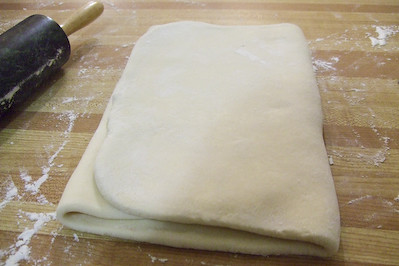
Rotate the dough so that the closed fold is to your left, like the spine of a book. Repeat the rolling and folding process, rolling the dough to a length of 24" and then folding it in thirds. This is the second turn.
Chilling the Dough:If the dough is still cool and no butter is oozing out, you can give the dough another two turns now. If the condition of the dough is iffy, wrap it in plastic wrap and refrigerate it for at least 30 minutes. Each time you refrigerate the dough, mark the number of turns you've completed by indenting the dough with your fingertips. It is best to refrigerate the dough for 30 to 60 minutes between each set of two turns.
The total number of turns needed is six. If you prefer, you can give the dough just four turns now, chill it overnight, and do the last two turns the next day. Puff pastry is extremely flexible in this regard. However, no matter how you arrange your schedule, you should plan to chill the dough for at least an hour before cutting or shaping it.


